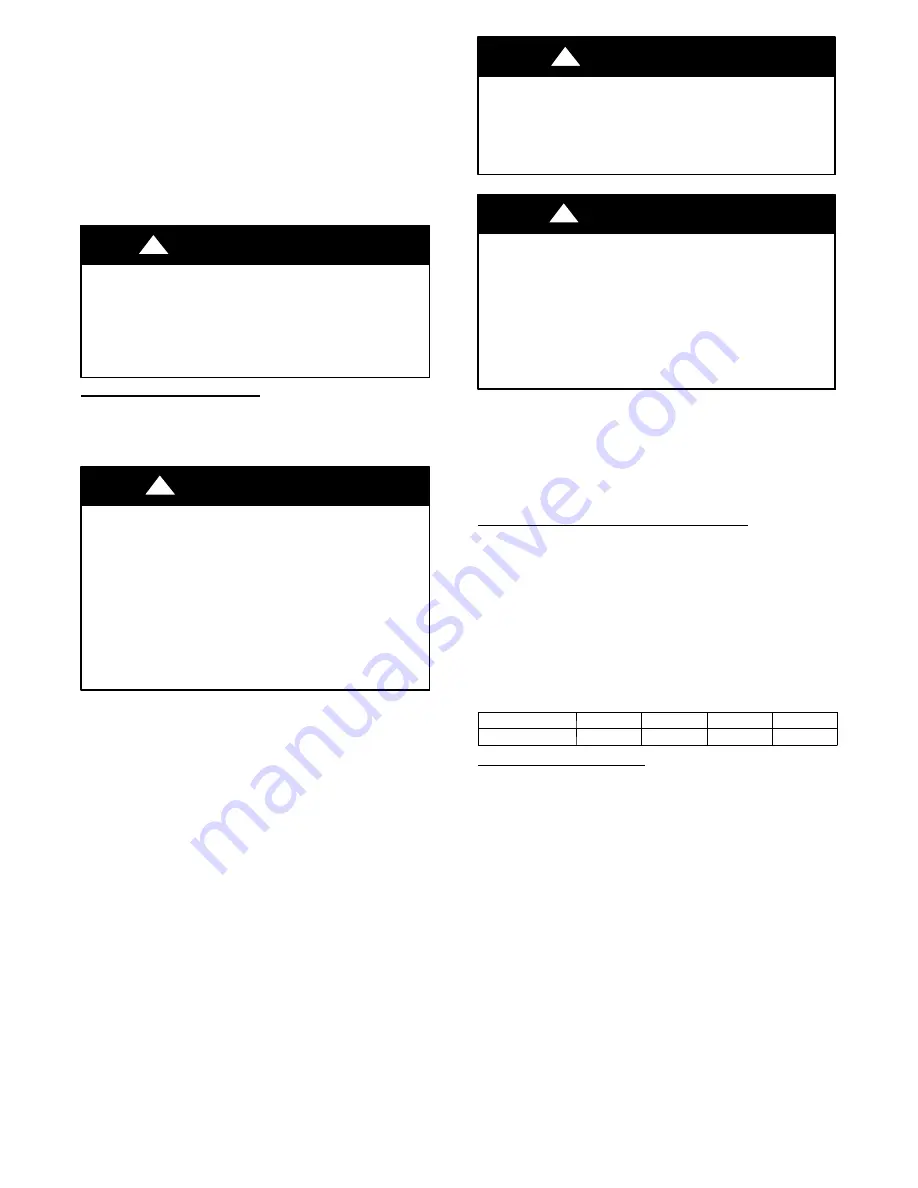
56
440 01 6201 00B
Specifications subject to change without notice.
e until correct input is achieved. Re--install regulator seal
cap on gas valve.
3. Restore furnace to normal operating condition.
a. Turn gas valve ON/OFF switch to OFF.
b. Remove water column manometer or similar device from
manifold pressure tap.
c. Tighten set screw on manifold tower pressure tap with
3/32--in. hex wrench, or if
⅛
--in. NPT plug was removed,
apply pipe dope sparingly to end of plug and re--install in
the gas valve.
d. Turn gas valve ON/OFF switch to ON.
e. Check for gas leaks and verify furnace operation.
FIRE HAZARD
Failure to follow this warning could result in personal
injury, death, and/or property damage.
Manifold pressure tap set screw must be tightened and
1/8--in. NPT pipe plug must be installed to prevent gas
leaks.
!
WARNING
Adjust Temperature Rise
NOTE
: Blower door must be installed when taking temperature
rise reading. Leaving blower door off will result in incorrect
temperature measurements, due to possible changes in duct static
pressure and airflow.
FURNACE DAMAGE HAZARD
Failure to follow this caution may result in:
S
Overheating the heat exchangers or condensing flue gases
in heat exchanger areas not designed for condensate.
S
Shortened furnace life
S
Component damage.
Temperature rise must be within limits specified on furnace
rating plate. Recommended operation is at midpoint of rise
range or slightly above.
CAUTION
!
This furnace must operate within the temperature rise ranges
specified on the furnace rating plate. Determine the air temperature
as follows:
1. Place duct thermometers in return and supply ducts as close
to furnace as possible. Be sure thermometers do not “see”
heat exchangers so that radiant heat does not affect
thermometer readings. This is particularly important with
straight run ducts.
2. When thermometer readings stabilize, subtract return--air
temperature from supply--air temperature to determine
temperature rise.
If the temperature rise is outside this range, check the following:
1. Gas input rate.
2. Derate for altitude ,if applicable.
3. Return and supply ducts for excessive restrictions causing
static pressures greater than 0.50--in. w.c. (125 Pa)
4. Adjust temperature rise by adjusting blower speed.
Referemce Table 9 -- Air Delivery for available heating
airflow ranges.
S
Increase blower speed to reduce temperature rise.
S
Decrease blower speed to increase temperature rise.
ELECTRICAL OPERATION HAZARD
Failure to follow this warning could result in personal injury
or death.
Disconnect 115vac electrical power before changing speed tap.
!
WARNING
(Read following caution before changing taps).
UNIT DAMAGE HAZARD
To avoid operating outside the rise range and avoid
component damage:
Refer to the Air Delivery Tables to determine which airflows
and settings are allowed for proper heating airflow. DO NOT
use the highlighted settings for Heating airflow.
The
highlighted settings are to be used for Cooling and
Continuous Fan ONLY.
CAUTION
!
Change the blower heat taps as required to maintain proper
temperature rise for Heating and Cooling as described above. To
change blower motor speed selections for heating mode, remove
blower motor lead from control HEAT terminal. See Fig. 36.
Select desired blower motor speed lead from one of the other
motor leads and relocate it/them to HEAT (heating blower tap)
terminal(s). Reconnect original lead on SPARE terminal.
Adjust Blower Off Delay (Heat Mode)
If desired, the main blower off time delay period may be
lengthened or shortened when operating in the heating mode to
provide greater comfort. For position and location of jumpers on
control center, see Fig. 36 and Fig. 72.
The blower off delay has four adjustable settings from 90 sec to
180 sec. See Table 19. The blower off delay jumpers are located
on the furnace control See Fig. 36 and 72. To change the blower
off delay setting, move the jumper from one set of pins on the
control to the pins used for the desired blower off delay. Factory
blower off delay setting is 120 sec.
Table 19 – Blower Off Delay Jumper Positions
PINS
1 AND 2
2 AND 3
3 AND 4
4 AND 5
Time (in sec.)
90
120
150
180
Adjust Cooling Airflow
The cooling airflow can be set from the remaining blower speed
taps. Refer to the Air Delivery Tables in these instructions.
If the same motor speed tap is needed for heating and cooling, a
Jumper Wire accessory kit is available, see Specification sheet for
the current Jumper Wire accessory part number. The single wire
end of the jumper will be connected to the desired blower motor
speed lead. The two wire end of the jumper will be connected to
the control board, connecting one wire to the HEAT (heating
blower tap) terminal and the other will be connected to the COOL
(cooling blower tap). Use the provided wire ties to secure the loose
blower motor speed lead and any other loose wires, being careful
not to put tension on any wire connectors.
















































